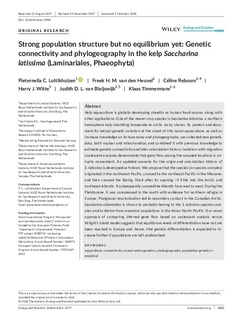| dc.contributor.author | Luttikhuizen, Pieternella C. | |
| dc.contributor.author | van den Heuvel, Freek H. M. | |
| dc.contributor.author | Rebours, Celine | |
| dc.contributor.author | Witte, Harry J. | |
| dc.contributor.author | van Bleijswijk, Judith D. L. | |
| dc.contributor.author | Timmermans, Klaas | |
| dc.date.accessioned | 2018-09-10T12:23:13Z | |
| dc.date.available | 2018-09-10T12:23:13Z | |
| dc.date.created | 2018-04-05T20:41:36Z | |
| dc.date.issued | 2018-04-02 | |
| dc.identifier.citation | Ecology and Evolution. 2018, 8 (8), 4265-4277. | nb_NO |
| dc.identifier.issn | 2045-7758 | |
| dc.identifier.uri | http://hdl.handle.net/11250/2561783 | |
| dc.description.abstract | Kelp aquaculture is globally developing steadily as human food source, along with other applications. One of the newer crop species is Saccharina latissima, a northern hemisphere kelp inhabiting temperate to arctic rocky shores. To protect and docu-ment its natural genetic variation at the onset of this novel aquaculture, as well as increase knowledge on its taxonomy and phylogeography, we collected new geneticdata, both nuclear and mitochondrial, and combined it with previous knowledge to estimate genetic connectivity and infer colonization history. Isolation-with- migration coalescent analyses demonstrate that gene flow among the sampled locations is vir -tually nonexistent. An updated scenario for the origin and colonization history of S. latissima is developed as follows: We propose that the species (or species complex) originated in the northwest Pacific, crossed to the northeast Pacific in the Miocene, and then crossed the Bering Strait after its opening ~5.5 Ma into the Arctic and northeast Atlantic. It subsequently crossed the Atlantic from east to west. During the Pleistocene, it was compressed in the south with evidence for northern refugia in Europe. Postglacial recolonization led to secondary contact in the Canadian Arctic. Saccharina cichorioides is shown to probably belong to the S. latissima species com -plex and to derive from ancestral populations in the Asian North Pacific. Our novel approach of comparing inferred gene flow based on coalescent analysis versus Wright’s island model suggests that equilibrium levels of differentiation have not yet been reached in Europe and, hence, that genetic differentiation is expected to in -crease further if populations are left undisturbed. | nb_NO |
| dc.description.abstract | Strong population structure but no equilibrium yet: Genetic connectivity and phylogeography in the kelp Saccharina latissima (Laminariales, Phaeophyta) | nb_NO |
| dc.language.iso | eng | nb_NO |
| dc.rights | Navngivelse 4.0 Internasjonal | * |
| dc.rights.uri | http://creativecommons.org/licenses/by/4.0/deed.no | * |
| dc.subject | Kelp aquaculture | nb_NO |
| dc.title | Strong population structure but no equilibrium yet: Genetic connectivity and phylogeography in the kelp Saccharina latissima (Laminariales, Phaeophyta) | nb_NO |
| dc.title.alternative | Strong population structure but no equilibrium yet: Genetic connectivity and phylogeography in the kelp Saccharina latissima (Laminariales, Phaeophyta) | nb_NO |
| dc.type | Journal article | nb_NO |
| dc.type | Peer reviewed | nb_NO |
| dc.description.version | publishedVersion | nb_NO |
| dc.rights.holder | © 2018 The Authors | nb_NO |
| dc.subject.nsi | VDP::Landbruks- og Fiskerifag: 900::Fiskerifag: 920::Akvakultur: 922 | nb_NO |
| dc.source.pagenumber | 4265-4277 | nb_NO |
| dc.source.volume | 8 | nb_NO |
| dc.source.journal | Ecology and Evolution | nb_NO |
| dc.source.issue | 8 | nb_NO |
| dc.identifier.doi | 10.1002/ece3.3968 | |
| dc.identifier.cristin | 1577804 | |
| dc.relation.project | EC/FP7/IDREEM/308571 | nb_NO |
| dc.relation.project | EC/FP7/2007-2013 | nb_NO |
| cristin.ispublished | true | |
| cristin.fulltext | original | |
| cristin.qualitycode | 1 | |

